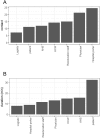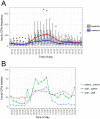Measuring dynamic social contacts in a rehabilitation hospital: effect of wards, patient and staff characteristics
- PMID: 29374222
- PMCID: PMC5786108
- DOI: 10.1038/s41598-018-20008-w
Measuring dynamic social contacts in a rehabilitation hospital: effect of wards, patient and staff characteristics
Erratum in
-
Author Correction: Measuring dynamic social contacts in a rehabilitation hospital: effect of wards, patient and staff characteristics.Sci Rep. 2020 Jan 30;10(1):1827. doi: 10.1038/s41598-020-57824-y. Sci Rep. 2020. PMID: 31996708 Free PMC article.
Abstract
Understanding transmission routes of hospital-acquired infections (HAI) is key to improve their control. In this context, describing and analyzing dynamic inter-individual contact patterns in hospitals is essential. In this study, we used wearable sensors to detect Close Proximity Interactions (CPIs) among patients and hospital staff in a 200-bed long-term care facility over 4 months. First, the dynamic CPI data was described in terms of contact frequency and duration per individual status or activity and per ward. Second, we investigated the individual factors associated with high contact frequency or duration using generalized linear mixed-effect models to account for inter-ward heterogeneity. Hospital porters and physicians had the highest daily number of distinct contacts, making them more likely to disseminate HAI among individuals. Conversely, contact duration was highest between patients, with potential implications in terms of HAI acquisition risk. Contact patterns differed among hospital wards, reflecting varying care patterns depending on reason for hospitalization, with more frequent contacts in neurologic wards and fewer, longer contacts in geriatric wards. This study is the first to report proximity-sensing data informing on inter-individual contacts in long-term care settings. Our results should help better understand HAI spread, parameterize future mathematical models, and propose efficient control strategies.
Conflict of interest statement
The authors declare that they have no competing interests.
Figures





References
-
- World Health Organization, (Who). Antimicrobial resistance. Global Report on Surveillance. Bulletin of the World Health Organization61 (2014).
Publication types
MeSH terms
LinkOut - more resources
Full Text Sources
Other Literature Sources
Medical

